Showing posts with label Sunomono. Show all posts
Showing posts with label Sunomono. Show all posts
Saturday, May 7, 2011
Amaebi Ceviche 甘エビのサビーチェ
This is what I made from the two largest amaebi shrimp we received from the latest shipment of goodies from Catalina Offshore products. This is more like a classic ceviche than the one in the previous post. In addition, I remembered that we had an interesting Martini glass and used it to serve the amaebi ceviche. I am going to present a tight shot, followed by a long shot, and a longest shot this time.
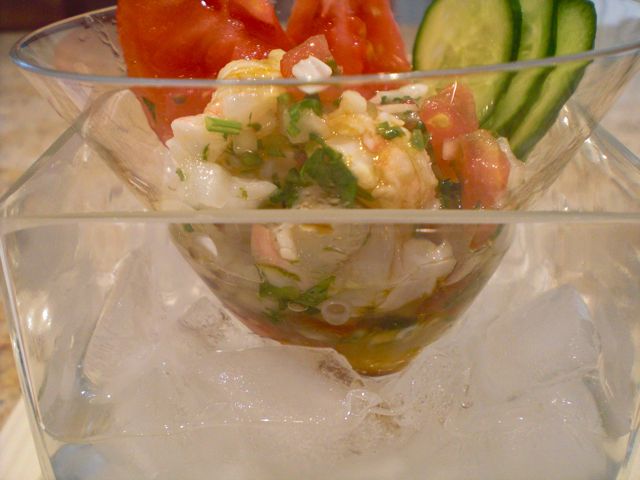
After I removed the head and roe (both shrimp had a large amount of roe) which was used in miso soup, I removed the shell and tail. I deveined and then cut it into small rounds. The marinade is mixture of freshly squeezed lime juice (4-5 tbs from 2 limes) and yuzu juice (1/2 tsp from the bottle). I added the zest of the lime (1/2 tsp, grated by a micro-grater), Vidalia spring onion (half, finely chopped), tomatoes (half, deseeded, skinned, and diced), Jalapeno pepper (1/2, seed and veins removed and finely chopped), parsley (1/2 tsp, finely chopped), salt and pepper. I mixed this into the marinade and added the shrimp. I let it steep (chemically cook) for few hours in the refrigerator.
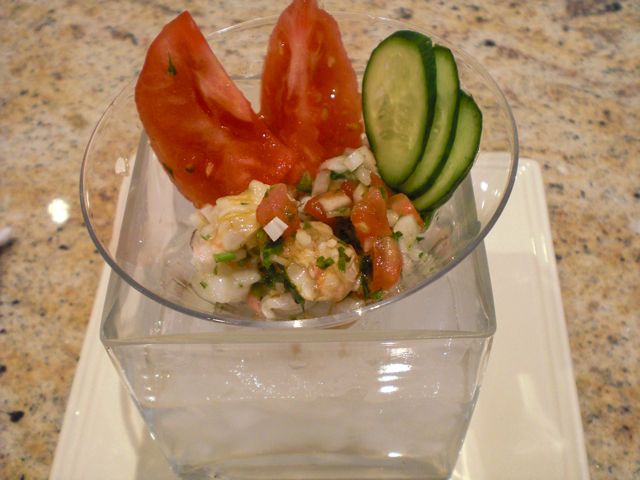
To serve, I drained the excess marinade, added a splash of good olive oil, sake, Tabasco (after tasting, I thought, it needed a bit more heat), and soy sauce. I placed it in the Martini glass on ice and garnished it with wedge of tomato and cucumber slices.
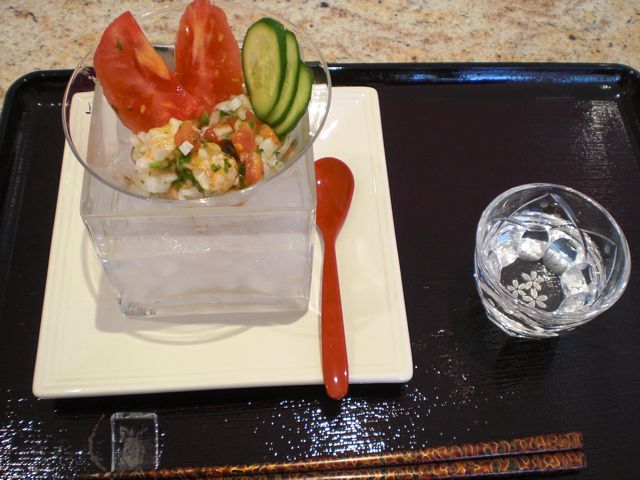
Cold sake appears to be appropriate for this dish. Compared to the previously posted amaebi ceviche which is not really (chemically) cooked, this is more like a traditional ceviche, and it tasted good. I did this because, although the shrimp was packed with ice in the meat conpartment of the refregirator, it had been 2 days since we received the live amaebi.
Wednesday, April 6, 2011
Salt-preserved wakame salad 塩蔵わかめの酢の物
Wakame わ かめ is one type of edible seaweed commonly used in Japanese cooking especially in soup or salad (sunomono 酢の物). Wakame can be bought fresh or "nama" 生 (available only seasonally in Japan--not here in the U.S.). Other preparations are salt preserved or "enzou" 塩蔵, and dried or "kansou" 乾燥. Except for fresh wakame, all others are first briefly boiled (which turns the natural brown color of wakame to the green we are familiar with), then, either salt-preserved or dried. The dried variety is most commonly available here in the U.S. and its shelf-life is very long. It is also very convenient (just put it in a soup or hydrate before use) but it lacks flavor and texture. Since it is next to impossible to get fresh wakame, the next best thing is to salt-preserved wakame especially if you are a wakame connoisseur.
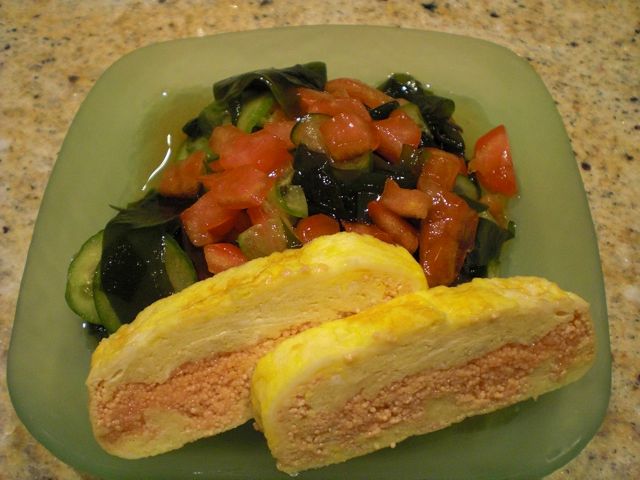
 I found a package of salt preserved wakame in a near-by Japanese grocery store. I included this picture to show you that this salt-preserved wakame came from "Sanriku" 三陸, the area devastated in the earthquakes and tsunami on March 11, 2011. (Although the Japanese writing on the package said "raw wakame" 生わかめ, this is salt-preserved not "raw".) When you take out one strand of wakame, it looks like the one on the left of the image below.
I found a package of salt preserved wakame in a near-by Japanese grocery store. I included this picture to show you that this salt-preserved wakame came from "Sanriku" 三陸, the area devastated in the earthquakes and tsunami on March 11, 2011. (Although the Japanese writing on the package said "raw wakame" 生わかめ, this is salt-preserved not "raw".) When you take out one strand of wakame, it looks like the one on the left of the image below.
To use this type of wakame is rather easy and it re-hydrates faster than the dried kind. I just washed it in cold running water to remove the salt and then soaked it in water for a few minutes. It re-hydrated and went back to its natural size and consistency as seen on the right of the image below. It was boiled before being salt preserved. As a result, the hydrated wakame has a nice green color. Since it is not pre-cut, I had to cut it into appropriate size pieces after squeezing out the excess water.
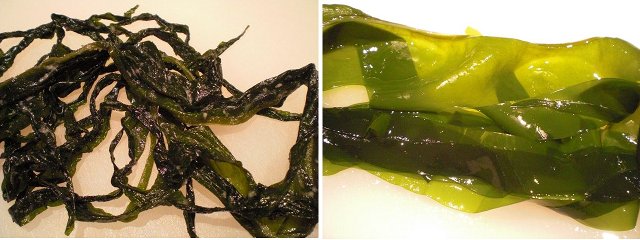
I just made my ususal sunomono with salt-preserved wakame, cucumber and diced (or concasse of) tomato. For dressing, you could use bottled sushi vinegar, "sanbai-zu" 三杯酢 (you mix rice vinegar 3 tbs, soy suace 1 tsp, salt 1/3 tsp, and sugar 1/2 tbs), or Ponzu shouyu ポン酢醤油 (from the bottle). You could also make sumiso 酢みそ dressing if you like. I used sanbai-zu. Sometimes, I also add a small amount of good olive oil or sesame oil to make it interesting. Since I had a small piece of tarako omelet left over, I also added the slices.
I just made my ususal sunomono with salt-preserved wakame, cucumber and diced (or concasse of) tomato. For dressing, you could use bottled sushi vinegar, "sanbai-zu" 三杯酢 (you mix rice vinegar 3 tbs, soy suace 1 tsp, salt 1/3 tsp, and sugar 1/2 tbs), or Ponzu shouyu ポン酢醤油 (from the bottle). You could also make sumiso 酢みそ dressing if you like. I used sanbai-zu. Sometimes, I also add a small amount of good olive oil or sesame oil to make it interesting. Since I had a small piece of tarako omelet left over, I also added the slices.
Is salt preserved wakame better than dried? For sunomono, I think it is. For soup, the difference is less noticeable. The salt preserved wakame should last a few weeks in the refrigerator after opening the package and if you freeze it, should last at least 5-6 months. The dried wakame may last a few years. You have to try it to determine if getting salt-preserved wakame is worth it for you.
Tuesday, October 12, 2010
Three dishes with Miso mustard vinegar dressing からし酢みそ和え、三種類
I am not sure this is even worth posting. Here are three variations on the theme of "sumiso ae" 酢みそ和え.
1. Squid legs and crab salad イカのゲソとかにのからし酢みそ和え
2. Crab meat, semi-dried scallop, and sakuraebi カニ、貝柱、桜えびの酢味噌和え
3. Baby octopus, snake-belly-cut cucumber and tomato 子鮹と蛇腹切りのキュウリの酢みそ和え
Monday, August 9, 2010
Grilled salmon with Ponzu soy sauce and Grated Daikon radish 焼塩鮭のポン酢みぞれ和え
I grated the daikon and squeeze out the excess liquid (about 1/4 cup) and added ponzu soy sauce (about 1 tbs from the bottle). I then crumbled the grilled salmon leftovers and mixed them into the daikon. I splashed Yuzu juice (from the bottle) on the top and garnished with finely julienned radish and finely sliced scallion (I used the green part for color). A simple quick dish but it was quite nice with cold sake. A good start.
Monday, August 2, 2010
Myouga pickled in sweet vinegar 冥加の甘酢漬 Myouga asazuke 冥加の浅漬
This is probably the last installment of my "myouga" series. This year's crop was not as good as other years but we had enough myouga to enjoy.
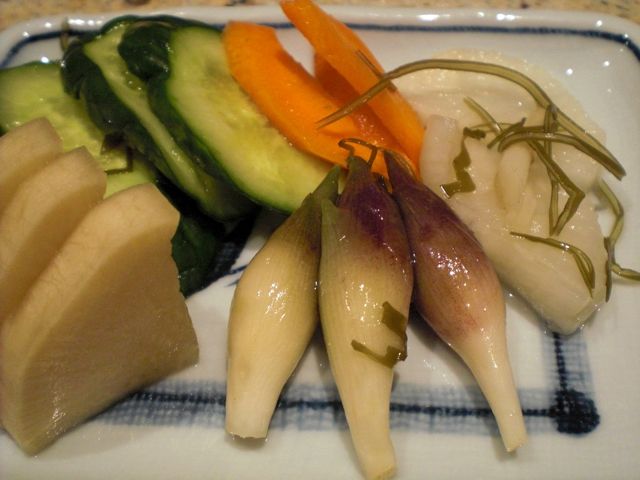
I think I am running out of myouga recipes. You could of course use finely chopped myouga as a condiment for anything including cold tofu 冷や奴, miso or clear soup, chawanmushi 茶碗蒸し, noodle dishes, sunomono 酢の物 dishes etc.
The picture below is myouga in sweet vinegar. This is a rather common preparation of myouga and I was told you could get this as a commercial product (in Japan). The recipe is rather simple. I first make sweet vinegar by dissolving sugar in Japanese rice vinegar (I used about 100m of vinegar with 4 tbs of sugar but the proportion is to your taste. I thought this was a bit too sweet but my wife thought it was just fine). I just microwaved it for 30-40 seconds or until the vinegar is warm enough to dissolve the sugar completely. Do not boil, it will make the vinegar less potent. (On the other hand, you may want to gently boil it in a pan to make the sweet vinegar more mellow). I then blanched the cleaned myouga, drained and added it to the sweet vinegar while the myouga are still hot. I keep this in a refrigerator for at least 3 days before eating. The one shown here is about a week old and still nicely crunchy with a sweet vinegar flavor mixed with the distinctive myouga taste. I do not know how long this will keep but I am sure, at least, several weeks. This is perfect for sipping sake or with rice.
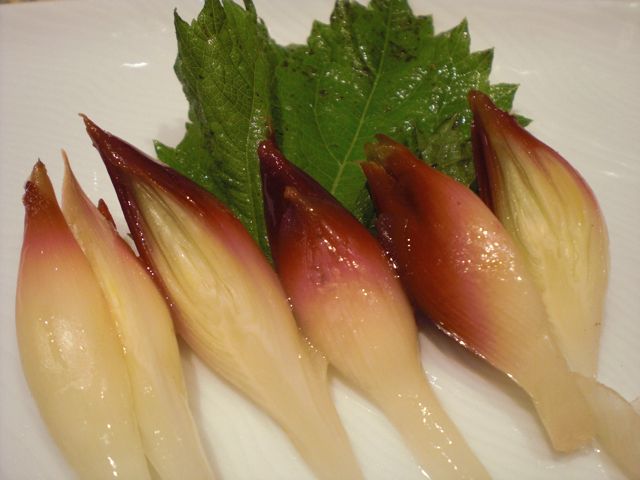 This is an assortment of asazuke 浅漬け (cucumber, carrot, daikon, in the back from left to right) and beer marinated daikon (front left) but the main item is, of course, myouga. I made the other vegetables exactly the same way as I posted before but I did not add ginger or hot pepper flakes. In addition to the nice myouga buds, I also added the chopped up stalk of myouga as well. This one has a purely myouga flavor with nice crisp texture.
This is an assortment of asazuke 浅漬け (cucumber, carrot, daikon, in the back from left to right) and beer marinated daikon (front left) but the main item is, of course, myouga. I made the other vegetables exactly the same way as I posted before but I did not add ginger or hot pepper flakes. In addition to the nice myouga buds, I also added the chopped up stalk of myouga as well. This one has a purely myouga flavor with nice crisp texture.
Sunday, July 11, 2010
Grilled squid, wakame and myouga in vinegar miso sauce イカとワカメ, 茗荷の酢みそ和え
This is a made-from-leftover dish and very similar to the dish I posted previously but since we harvested the very first myouga 茗荷, this is a preview of the myouga dishes to come. We grilled marinated squid (in lemon zest, olive oil, fresh thyme etc) few days ago but it was not a roaring success. I used this leftover squid, combined with a type of sea vegetable called "wakame" 若布, and cucumber to make this small starter dish. I added the star attraction--a garnish of myouga.
I thinly sliced cucumber (American mini cucumber) and salted the slices. I squeezed out the excess moisture and lightly dressed it with sushi vinegar. For "wakame", after re-hydration, I squeezed out the excess water and also lightly dressed it with sushi vinegar. Before dressing with a "sumiso" sauce, I again squeezed out excess liquid from both the cucumber and wakame. I sliced the left over grilled squid into thin rings.
Karashi sumiso sauce: This is my regular sumiso sauce with miso (I used red miso this time without any particular reason), sugar and rice vinegar with Japanese hot mustard.
After dressing everything in the sumiso, I garnished with a perilla leaf, sliced Campari tomato, and fresh myouga (just a cameo appearance of myouga here). Because of the karashi sumiso, the squid tasted better and the myouga has such a unique taste it really added to the dish.
We are still waiting for the myouga to get a bit larger.
Wednesday, June 23, 2010
"Mozuku" and "Nagaimo" in sweet vinegar モズクと長芋の甘酢
The Japanese eat anything which comes out from the sea and also like combining slimy food with slimy food (double slim or, sometimes, triple slim). I got inspired (??) from the reportedly mediocre dish I saw in Jon's posting. I occasionally get a type of slimy sea vegetable called "Mozuku" もずく, which is already prepared in sweet vinegar and packaged in a plastic cup, which I get frozen. The southernmost archipelago of Japan, Okinawa 沖縄, is famous for Mozuku. Since I had an end piece of "Nagaimo" 長芋 left over, I simply peeled, sliced and made it into match stick shaped pieces. I used sushi vinegar to lightly dress it and placed it over the mozuku and garnished with another type of aquatic vegetable called "aonori" 青のり which is dried and comes as small flakes.

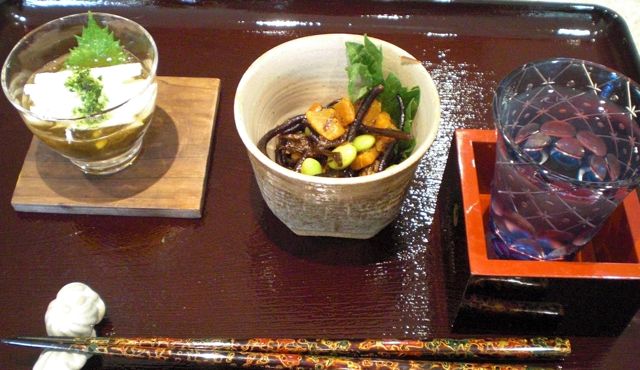
The nagaimo has a nice crispy texture with some sliminess (but nothing compared to grated nagaimo) and mozuku has a bit similar characteristic and is the perfect match. The sweet vinegar is very gentle and we slurped whatever was left in the cup. Actually, I served this in a crystal sake cup "guinomi" ぐいのみ also from Kitaichi glass, so this was a very natural thing to do.
It was an exceptionally nice day for mid June and we fired up the Konro grill outside and this was a part of the starter dishes pictured below. I already had stewed "hijiki" which I had made previously (middle). The cut glass tumbler from Kitaichi glass (on the right) is tall and a bit unstable so I used "masu" 升, a square wooden Japanese measuring cup, to stabilize it. This happens to be the common way in which sake is served in an Izakaya. They intentionally pour sake to overflow the cup and let the sake spill over into the "masu" underneath as a gesture of generosity. Although we need not to do that since we are quite generous to ourselves when it comes to sake, I recall Dave was not too happy at Shuto-an 酒徒庵 since they did not serve sake this way.
Friday, March 19, 2010
Squid, cucumber and sea weed salad イカ、胡瓜と海藻の酢みそ和え
This is a rather classic Japanese small salad belonging to a large category of "Sunomono" 酢の物. When sea food is added to the salad, it is most common to use "sumino" 酢みそ as a dressing. I have posted dishes using sumiso before.
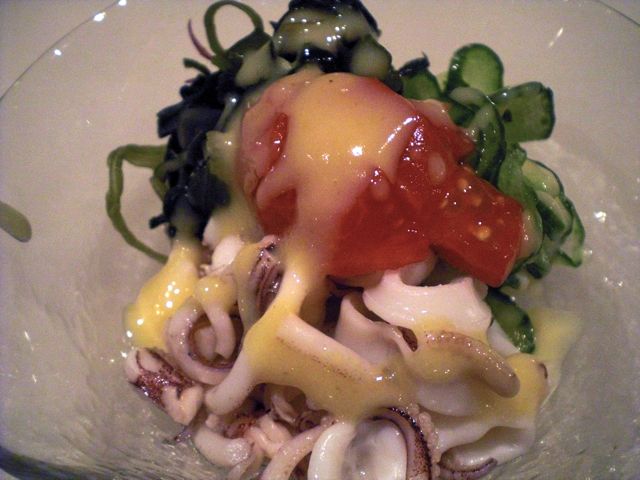
I used boiled squid, seaweed, and cucumber in this dish.
Seaweed: I soak dried "seaweed salad" (comes in a pouch with several kinds of edible seaweeds but you could use just "wakame" 若布) in water and let it rehydrate for 15 or more minutes. Squeeze out excess water and dress it with sushi vinegar and, again, squeeze out excess liquid before assembly.
Squid: I use several bodies and tentacles of very small (body is about 2-3 inch long) cleaned squid. I cook it in boiling water with salt and sake for 30 seconds to 1 minutes (Do not over cook). After removing from the water and tasting, I sprinkle on a bit of salt and sushi vinegar while it is hot and let it cool. If you salted the water enough, you may not need to salt here.
Cucumber: This is an usual treatment of cucumber; I use one mini-cucumber, sliced thinly. I lightly salt the cucumber, mix, and let it stand for several minutes. I ring out the excess water and dress it with sushi vinegar. I, again, squeeze out excess sushi vinegar before assembly.
Dressing ("Karashi sumiso" 芥子酢みそ): I use 2 tsp of sweet miso ("saikyou miso" 西京味噌), 1/3 tsp of prepared Japanse hot mustard (in a tube), 1/3 tsp of sugar, 2 tsp of rice vinegar. After checking the taste and consistency, I add either broth "dashi" or mirin to make adjustment (this time, I added very small amount of mirin).
Assembly: Squeeze out excess shushi vinegar and liquid from the cucumber and seaweed. I arragne the ingredients in three small mounds as you can see in the picture and garnish it with small wedges of skinned Campari tomato and drizzle on the dressing. I used the dressing sparingly since all the ingreidients are already seasoned. The nutty flavor of miso, sweetness and tang of hot mustard punctuated with vinegary taste are perfect in this dish. You definitely need sake for this dish, although some sparkling wines such as Proseco would also go well.
Seaweed: I soak dried "seaweed salad" (comes in a pouch with several kinds of edible seaweeds but you could use just "wakame" 若布) in water and let it rehydrate for 15 or more minutes. Squeeze out excess water and dress it with sushi vinegar and, again, squeeze out excess liquid before assembly.
Squid: I use several bodies and tentacles of very small (body is about 2-3 inch long) cleaned squid. I cook it in boiling water with salt and sake for 30 seconds to 1 minutes (Do not over cook). After removing from the water and tasting, I sprinkle on a bit of salt and sushi vinegar while it is hot and let it cool. If you salted the water enough, you may not need to salt here.
Cucumber: This is an usual treatment of cucumber; I use one mini-cucumber, sliced thinly. I lightly salt the cucumber, mix, and let it stand for several minutes. I ring out the excess water and dress it with sushi vinegar. I, again, squeeze out excess sushi vinegar before assembly.
Dressing ("Karashi sumiso" 芥子酢みそ): I use 2 tsp of sweet miso ("saikyou miso" 西京味噌), 1/3 tsp of prepared Japanse hot mustard (in a tube), 1/3 tsp of sugar, 2 tsp of rice vinegar. After checking the taste and consistency, I add either broth "dashi" or mirin to make adjustment (this time, I added very small amount of mirin).
Assembly: Squeeze out excess shushi vinegar and liquid from the cucumber and seaweed. I arragne the ingredients in three small mounds as you can see in the picture and garnish it with small wedges of skinned Campari tomato and drizzle on the dressing. I used the dressing sparingly since all the ingreidients are already seasoned. The nutty flavor of miso, sweetness and tang of hot mustard punctuated with vinegary taste are perfect in this dish. You definitely need sake for this dish, although some sparkling wines such as Proseco would also go well.
Thursday, September 17, 2009
Grilled Chicken Thigh with salt 鶏の塩焼き
Grilled Chicken Thigh with Salt 鶏の塩焼き
When it is too much to set up a yakitori grill outside, the next best thing is to make this dish. Since skin is an important element of this dish, you probably have to get bone-in thigh and bone it yourself. Remove excess fat and butterfly the thickest part to make it even in thickness. Simply salt both sides (may not be good for you but you need to salt it quite heavily to taste good). For a grill, I use a very small electric indoor grill (George Forman's brand) but the grill needs to get rather hot. If you use a grill which can cook both sides at once, I put skin side up to make skin crispy. You can certainly make this with a frying pan or a grill pan. In that case, you put skin side down first and weight it down by a panini press or similar heavy item. You need to remove excess fat using paper towel while cooking to make the skin brown and crispy then turn over to complete cooking (do not cover). The result is very crispy skin and juicy thigh meat. Cut it up into bite size pieces, squeeze lemon and enjoy
Vinegared cucumber salad キュウリの酢の物
I served this with a cold sake and a simple cucumber salad or "sunomono" 酢の物 with finely テ貝の薫製 from Hokkaido and topped with salmon roe いくら. Since it was a week night, I cheated and just used bottled Sushi vinegar (good quality one like "Mitsukan" or "Mizkan"ミツカン brand and one which uses real rice vinegar, not distilled white vinegar). After thinly slicing cucumbers, salt them lightly, mix and leave them for 5 minutes before squeezing out excess water. Mix with scallops and dress. Top with salmon roe.
crumbled semi-dry and smoked scallops ホタ
crumbled semi-dry and smoked scallops ホタ
The sake glass is made by a local artisan in Asakusa, Tokyo, "Hashi-oki" 箸置き or "chop stick pillow" is also hand-made by Kitaichi glass, in Otaru, Hokkaido, and the cold sake is Yaegaki "mu" 八重垣 ”無” Junmai Daiginjo 純米大吟醸. Not bad for a week night!
Monday, September 7, 2009
Sunomono 酢の物
Wakame with vinegar dressing わかめの酢の物

This type of side dish belongs to a general category of "sunomon" 酢の物 or "vinegard items". This is my version of wakame salad. Mark's Izakaya Cookbook has two entries of this kind;
VINEGARD WAKAME SALAD わかめ酢 (P16)
NANOHANA RABE AND WAKAME SEAWEED SALAD 菜の花とわかめのサラダ (P112)
You can make many variations by changing the dressing and/or adding (or removing) any ingredients available (or not available) at a given time. But you need to use vinegar dressing to qualify for "sunomono". The closest we can get for nanohana here in the U.S. is brocolli rabe (rapini) but it is too bitter and too tough to eat raw. For this dish, I blanched the broccoli rabe. For cucumber, in stead of Japanese cucumber, I used American "mini cucues" which became available in our grocery store recently. It is closest to Japanese cucumber in size and taste (of course, you could get a Japanese cucumber from a Japanese grocery store). I also added skinned tomato (we do not like tomato skin), avocado, and wakame. I cut the cucumber in "jabara" 蛇腹 or "snake belly" fashion as suggested in Mark's book. If you have not seen how this is done, please check out this youtube episode. For dressing, I used "ponzu" (ポン酢) here (Mark's book has a recipe p154 but good quality one can be bought in a bottle) but you can make "nihaizu" 二杯酢 (rice vinegar, soy sauce and dashi) or "sanbaizu" 三杯酢 ("nihaizu" plus mirin) or simply use "sushi vinegar" (this is not just rice vinegar but seasoned with sugar and salt) from the bottle. We usually omit "dashi" since the liquid from the vegetables takes out some of the harshness of the vinegar. Other common variations of the dressings, especially if you add seafood such as boiled squid legs, octopus, or shrimp, are "sumiso" 酢みそ (Miso paste, sugar and rice vinegar) and "karashi sumiso" ("sumiso" plus Japanese hot mustard).
This type of side dish belongs to a general category of "sunomon" 酢の物 or "vinegard items". This is my version of wakame salad. Mark's Izakaya Cookbook has two entries of this kind;
VINEGARD WAKAME SALAD わかめ酢 (P16)
NANOHANA RABE AND WAKAME SEAWEED SALAD 菜の花とわかめのサラダ (P112)
You can make many variations by changing the dressing and/or adding (or removing) any ingredients available (or not available) at a given time. But you need to use vinegar dressing to qualify for "sunomono". The closest we can get for nanohana here in the U.S. is brocolli rabe (rapini) but it is too bitter and too tough to eat raw. For this dish, I blanched the broccoli rabe. For cucumber, in stead of Japanese cucumber, I used American "mini cucues" which became available in our grocery store recently. It is closest to Japanese cucumber in size and taste (of course, you could get a Japanese cucumber from a Japanese grocery store). I also added skinned tomato (we do not like tomato skin), avocado, and wakame. I cut the cucumber in "jabara" 蛇腹 or "snake belly" fashion as suggested in Mark's book. If you have not seen how this is done, please check out this youtube episode. For dressing, I used "ponzu" (ポン酢) here (Mark's book has a recipe p154 but good quality one can be bought in a bottle) but you can make "nihaizu" 二杯酢 (rice vinegar, soy sauce and dashi) or "sanbaizu" 三杯酢 ("nihaizu" plus mirin) or simply use "sushi vinegar" (this is not just rice vinegar but seasoned with sugar and salt) from the bottle. We usually omit "dashi" since the liquid from the vegetables takes out some of the harshness of the vinegar. Other common variations of the dressings, especially if you add seafood such as boiled squid legs, octopus, or shrimp, are "sumiso" 酢みそ (Miso paste, sugar and rice vinegar) and "karashi sumiso" ("sumiso" plus Japanese hot mustard).
Subscribe to:
Posts (Atom)



